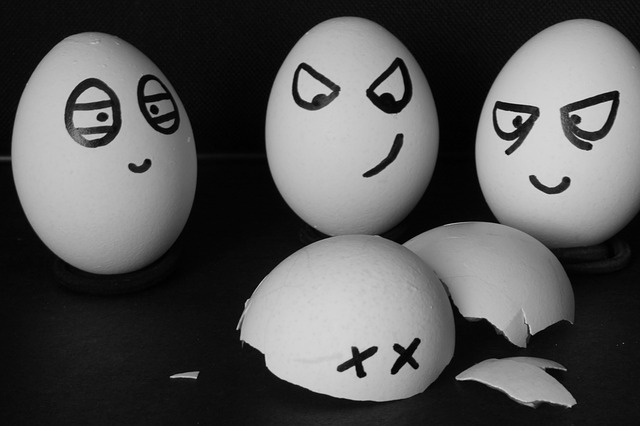If they are engaging in cyber-bullying or promoting the spread of the international slave trade, a Bad Egg classification is straightforward.

But what of those more domestic eggs that sit so silently in your pantry? How can you know what secrets lurk within their albumen?
There are varying theories, some more odd than others. Some say you should shine a strong light through it to see if there’s a chick inside. Others suggest shaking the egg to hear if it sloshes (it shouldn’t), or spinning it (it should stop after you touch its centre-point), or plopping it into water to see if it sinks (bad eggs are alleged to float).
With half a dozen suspect eggs on our hands, we decided to conduct an experiment. We tried the spinning, the shaking, and the sinking; before finally using the most reliable of all tests: cracking the eggs open. (Outside.) Results? Mixed.
 Egg #1 spun plentifully, gave a faint ‘thunka’ noise when shaken, and sank – on an angle.
Egg #1 spun plentifully, gave a faint ‘thunka’ noise when shaken, and sank – on an angle. 
Egg #2 also spun plentifully, sloshed when shaken (although this may have been due to the vigour of the shaking) and stood on end under water as all good eggs should. It was a passable egg – not fresh, but not rotten. Call it a curate’s egg.

Egg #3 spun less, kept quiet when shaken, and stood on end under water.
Egg #4 spun lots, kept quiet when shaken, and stood on end under water.
Egg #5 spun less, made a little bumping noise on being shaken, and sank on an angle. 
Egg #6 spun a bit, kept quiet, and sank upright after bobbing.
So…
An egg which sinks on an angle could be good or bad. An egg which sinks on end could be good, bad or indifferent. Not a very reliable test.
An egg which makes a noise when shaken could be good, bad or indifferent. An egg which remains silent could be good, bad or indifferent. Again, not a very reliable test.
An egg which spins a little could be indifferent or good. An egg which spins a lot could be indifferent or bad.
The obvious conclusions to draw are that spinning provides the closest thing to a working test, out of the three we sampled; and that simulated drowning and the use of force do not produce reliable information.
What methods have you tried for testing your eggs? Found anything that works?


I concur: the only way to tell, unless you have a fancy machine that sees through them, or has super-sniffing powers, is to crack them open. My mother always told me to crack it into a cup first, before adding it to the mix – wisdom probably borne of experience!
Indeed! There’s nothing worse than cracking the last egg into the bowl and finding you have to throw the whole lot out!
Good Egg! Great post. Love the photos.
Thanks! It’s wonderful what you can find under Creative Commons licences – and just as well, as I am not the most talented of photographers.
I’ve always used the water test, making sure they have plenty of space between the surface and the bottom. I can’t say for certain that every egg I ever threw away was definitely bad, but I can see with complete certainty that every egg I ever used was not bad.
There is something to be said for that, providing you have a sufficient quantity of eggs. Myself, I’d be driven by curiosity to open all the eggs anyway!